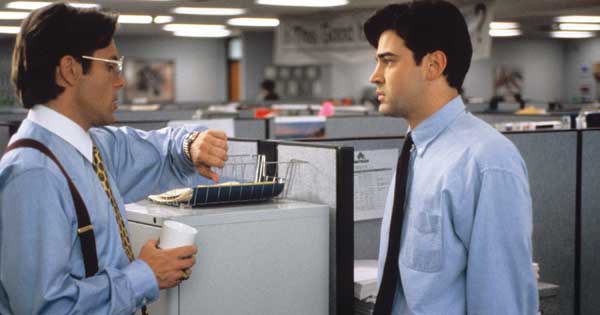
Cubed: A Secret History of the Workplace, By Nikil Saval, Doubleday, 352 pp., $26.95
If you believe that the soul-crushing office is unique to the 21st century, think again.
Throughout history, humans have tended to do business in miserable surroundings. In 1843, Dickens described Ebeneezer Scrooge’s counting house as a “tank” from which upright, healthy men emerged as stooped, wheezing husks. Bartleby the Scrivener, the “incurably forlorn” clerk in Melville’s eponymous 1853 tale, is shattered by office life. His famous defiance—“I would prefer not to”—leads first to prison, then death.
Thanks to ergonomic furniture, the modern-day cubicle—in which 60 percent of Americans perform their work—may be less physically crippling than its Dickensian predecessor. But it remains spiritually stifling.
In Cubed: A Secret History of the Workplace, critic and editor Nikil Saval makes a fierce if indirect case for telecommuting. He traces the evolution of the contemporary office from its dismal roots in the 19th century through a brief, golden point in the 1960s and back to the chronic oppressiveness of today. His descriptions are so spot-on that they often left me paralyzed with PTSD. Before becoming a freelancer, I logged years in a demoralizing newspaper office, complete with sealed windows, stale air, and a sea of “pods”—linked cubicles—that offered neither privacy nor community.
Saval grasps the anger such pods can cause. Cubed opens with a scene from the 1999 movie Office Space, in which sullen tech workers obliterate a workplace photocopier with baseball bats. Paraphrasing Rousseau, he crafts a rallying cry for the desk set: “Man is born free, but he is everywhere in cubicles.” Don’t, however, mistake Saval’s wit for fluff. Erudite in many disciplines, he uses the office as a lens through which to view centuries of Western history—moving easily between analyses of class stratification, fashions in architecture, and depictions of white-collar workers in literature and popular culture.
One paradox of the 19th-century clerk in America: although he—and it was invariably he—was sallow and weak, his frailness gave him greater social status than that of factory workers, who were often immigrants. Hired for their command of written English—which many immigrants lacked—clerks “dressed to the nines.” Yet their fancy clothes also drew accusations of effeminacy and introduced the idea of the office as a “feminized” space before any actual women were there.
At the turn of the century, women did finally arrive. They were “a new generation of their sex,” novelist Christopher Morley wrote, “cool, assured, even capable.” And they worked because they had no choice. In 1909, secretarial legend Katie Gibbs was flat broke and freshly widowed. To support herself, she learned stenography, and two years later—buoyed by her success—she sold her jewelry and founded a school that would give more women access to clerical skills. Soon the school became a chain, graduating classy, midcentury secretaries who had been taught to project “business prestige,” as well as to take dictation.
Gibbs paved the way for books like Rona Jaffe’s The Best of Everything (1958), which presents the urban office as an escape—albeit a sexually treacherous one—for provincial women. Billy Wilder’s The Apartment (1960), which Saval calls “the best office film of all time,” has a “bleaker spin.” It portrays the workplace as a “grotesque fraternity” in which male executives prey relentlessly on female subordinates.
At midcentury, modernism changed the look of American offices. No longer were they dank, lightless warrens. In Manhattan, two glass beacons signaled the transformation: Lever House, designed by Skidmore, Owings & Merrill, and the Seagram Building, designed by Mies van der Rohe. But perhaps the most radical experiment took place at Herman Miller, which hired designers Robert Propst and George Nelson to collaborate on what they called the Action Office in 1964—an attempt to unite “aesthetics of design and progressive ideas about human needs.”
The Action Office was a sort of humane cubicle—a successful merging of the need for privacy and community. But it spawned a wave of crude knockoffs. By the 1990s, these had morphed into the “veal-fattening pen,” author Douglas Coupland’s term for the contemporary cubicle.
Banishing walls and desks was not a solution, either, as advertising guru Jay Chiat learned when he designed an office without them. Chiat renamed meeting hubs “strategic business units,” an inane coinage that, Saval dryly observes, sounds “suspiciously like the ‘strategic hamlets’ of the Vietnam War.” Nor did postmodernism fix office problems, though the aesthetic may have in part been a response to critic Jane Jacobs’s fierce attack on modernism in The Death and Life of Great American Cities.
You might think freelancing—working outside an office—would resolve all issues. But freelancers have trouble getting paid and receiving benefits.
Cubed left me with a sinking hopelessness. How have humans survived these inexorable hells? Did they customize their spaces to make them more endurable? I received my answer not from Saval but from a Facebook status update.
“A new reporter joined the little group of cubicles we call The Funpod today,” wrote my friend Craig Pittman, an investigative reporter for the Tampa Bay Times. “So I showed him around a bit and told him of our many fine Funpod traditions—the Slinkies, the Quote Wall, and of course the [prosthetic] arm that dangles from our ceiling.” The new hire asked the reporter sitting beneath it if it bothered her. “Oh no,” she said. “I don’t even notice it anymore unless a tour group comes through.”

